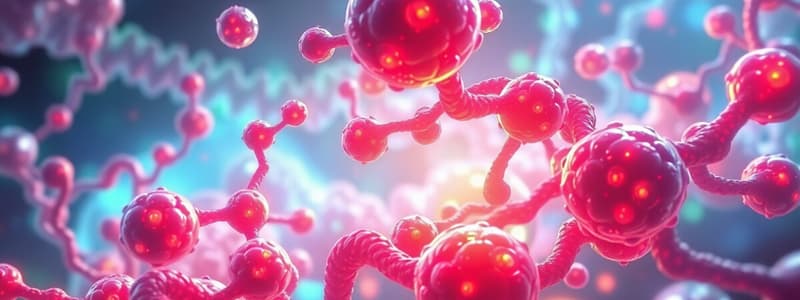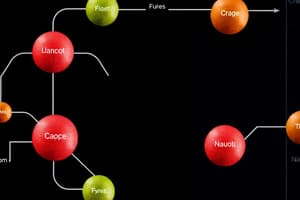Podcast
Questions and Answers
What is the primary function of glutaminase?
What is the primary function of glutaminase?
- To synthesize ammonia
- To break down D amino acids
- To generate glutamate and glutamine (correct)
- To detoxify peroxide
Ammonia is less toxic than the ammonium ion.
Ammonia is less toxic than the ammonium ion.
False (B)
What is the function of catalase in the body?
What is the function of catalase in the body?
To detoxify peroxide
Under physiological conditions, the concentration of the ammonium ion is approximately _____ times higher than ammonia.
Under physiological conditions, the concentration of the ammonium ion is approximately _____ times higher than ammonia.
Match the following cycles or enzymes with their respective functions:
Match the following cycles or enzymes with their respective functions:
What is the primary consequence of urea cycle defects?
What is the primary consequence of urea cycle defects?
Patients with urea cycle defects can tolerate high protein diets.
Patients with urea cycle defects can tolerate high protein diets.
What role does Alpha Keto Glutarate play in treating hyperammonemia?
What role does Alpha Keto Glutarate play in treating hyperammonemia?
The urea cycle converts ammonia into __________, which is then excreted from the body.
The urea cycle converts ammonia into __________, which is then excreted from the body.
Match the following urea cycle enzymes with their functions:
Match the following urea cycle enzymes with their functions:
Where do the first two enzymes of the urea cycle reside?
Where do the first two enzymes of the urea cycle reside?
Carbonyl phosphate is an activated form of urea.
Carbonyl phosphate is an activated form of urea.
What happens to nitrogen from ammonia in the urea cycle?
What happens to nitrogen from ammonia in the urea cycle?
Which enzyme is the rate-limiting enzyme of the urea cycle?
Which enzyme is the rate-limiting enzyme of the urea cycle?
The urea cycle is activated by high levels of ammonia in the blood.
The urea cycle is activated by high levels of ammonia in the blood.
What are the primary reactants for the production of Carbamyl phosphate?
What are the primary reactants for the production of Carbamyl phosphate?
Argininosuccinate is converted to __________ in the urea cycle.
Argininosuccinate is converted to __________ in the urea cycle.
Match the following urea cycle enzymes with their corresponding products:
Match the following urea cycle enzymes with their corresponding products:
Which of the following is NOT a precursor of urea?
Which of the following is NOT a precursor of urea?
Deficiencies in enzymes of the urea cycle can lead to hyperammonemia.
Deficiencies in enzymes of the urea cycle can lead to hyperammonemia.
Flashcards
Urine and Ammonia
Urine and Ammonia
Urine is acidic, trapping ammonia as ammonium ions, which are less toxic than ammonia.
Glutaminase & Asparaginase
Glutaminase & Asparaginase
Enzymes involved in nitrogen metabolism. Glutaminase removes nitrogen, generating glutamate and glutamine, intracellular nitrogen carriers.
L & D Amino Acid Oxidases
L & D Amino Acid Oxidases
Enzymes that break down amino acids. L oxidase uses FMN and produces peroxide, D oxidase uses FAD and also produces peroxide.
D Amino Acid Oxidase
D Amino Acid Oxidase
Signup and view all the flashcards
Glucose-Alanine Cycle (Cahill Cycle)
Glucose-Alanine Cycle (Cahill Cycle)
Signup and view all the flashcards
Catalase
Catalase
Signup and view all the flashcards
Ammonia Toxicity
Ammonia Toxicity
Signup and view all the flashcards
Urea Cycle
Urea Cycle
Signup and view all the flashcards
Location of Urea Cycle Enzymes
Location of Urea Cycle Enzymes
Signup and view all the flashcards
Carbamyl Phosphate Synthetase 1 (CPS 1)
Carbamyl Phosphate Synthetase 1 (CPS 1)
Signup and view all the flashcards
Ornithine Transcarbamylase
Ornithine Transcarbamylase
Signup and view all the flashcards
Hyperammonemia
Hyperammonemia
Signup and view all the flashcards
Urea Cycle Activation
Urea Cycle Activation
Signup and view all the flashcards
Urea Precursors
Urea Precursors
Signup and view all the flashcards
Hyperammonemia: Urea Cycle Enzymes
Hyperammonemia: Urea Cycle Enzymes
Signup and view all the flashcards
Hyperammonemia: Process
Hyperammonemia: Process
Signup and view all the flashcards
Hyperammonemia: Diagnosis
Hyperammonemia: Diagnosis
Signup and view all the flashcards
Ornithine Transcarbamylase (OTC) Deficiency
Ornithine Transcarbamylase (OTC) Deficiency
Signup and view all the flashcards
Carbamylphosphate Synthetase 1 (CPS 1) Deficiency
Carbamylphosphate Synthetase 1 (CPS 1) Deficiency
Signup and view all the flashcards
Hyperammonemia: Summary
Hyperammonemia: Summary
Signup and view all the flashcards
Study Notes
Urine and Ammonia
- Urine is acidic and traps ammonia in the form of ammonium ions, which are less toxic than ammonia.
- Glutaminase and Asparaginase play a role in nitrogen metabolism.
- Glutaminase removes nitrogen, generating glutamate and glutamine, which act as intracellular nitrogen carriers.
- Asparaginase is typically less critical, but it is an enzyme involved in nitrogen metabolism.
- L and D amino acid oxidases are involved in breaking down amino acids.
L and D Amino Acid Oxidases
- L amino acid oxidase uses FMN (flavine mononucleotide) and produces peroxide as a byproduct.
- D amino acid oxidase utilizes FAD and also produces peroxide.
- The D amino acid oxidase is important for breaking down D amino acids, which are often found in bacterial infections.
The Glucose-Alanine Cycle (Cahill Cycle)
- This cycle helps conserve glucose backbones.
- It involves converting alanine to pyruvate and then pyruvate back to glucose in the liver.
- Glucose is primarily used by the brain and red blood cells.
- It prevents muscle cells from using glucose, as this would lead to fatty acid and ketone body production.
The Importance of Catalase
- Catalase is an enzyme present in peroxisomes.
- It detoxifies peroxide generated by L and D amino acid oxidases.
Ammonia Toxicity
- Ammonia levels exceeding 10 micrograms per liter are toxic to cells.
- Ammonium ions are less toxic, with a toxic level of around half a milligram.
- However, physiological conditions maintain a 100-fold higher concentration of ammonium ions compared to ammonia.
Urea Cycle
- A complete blockage in any step of the urea cycle is fatal.
- The urea cycle detoxifies ammonia in the liver, converting it into urea.
- Urea is then excreted from the body.
Location of Urea Cycle Enzymes
- The first two enzymes, Carbamylphosphate synthetase 1 (CPS1) and Ornithine transcarbamylase, are located in the mitochondrial matrix.
- The remaining three enzymes are located in the cytosol.
Carbamyl Phosphate Synthetase 1 (CPS 1)
- CPS 1 is the initial enzyme in the urea cycle.
- It catalyzes the reaction between bicarbonate and ammonium ions, forming carbamyl phosphate.
- Carbamyl phosphate is an activated form of urea, containing a phosphate group on one end and a nitrogen group on the other.
Ornithine Transcarbamylase
- This enzyme catalyzes the reaction between ornithine and carbamyl phosphate, leading to the formation of citrulline.
Urea Cycle Reactions:
- CPS1: Bicarbonate + Ammonium ion → Carbamyl phosphate
- Ornithine Transcarbamylase: Ornithine + Carbamyl phosphate → Citrulline
- Arginosuccinate Synthetase: Citrulline + Aspartate → Arginosuccinate
- Arginosuccinate Lyase: Arginosuccinate → Arginine
- Arginase: Arginine → Urea
Hyperammonemia
- Hyperammonemia refers to elevated ammonia levels in the blood.
- Deficiencies in urea cycle enzymes can cause hyperammonemia.
Activation of the Urea Cycle
- The urea cycle is activated by a flow of nitrogen.
- N-Acetylglutamate Synthetase regulates this, producing N-acetylglutamate, which activates CPS1.
Urea Precursors
- Aspartate, free ammonium ions, and carbamyl phosphate are the precursors providing nitrogen for the urea cycle.
Hyperammonemia: Urea Cycle
- The urea cycle involves two key enzymes: CPS 1 and OTC.
- CPS 1 is the rate-limiting enzyme, regulated by N-acetylglutamate.
Hyperammonemia: Process
-
- Ammonium ion + Bicarbonate → Carbamyl phosphate (via CPS 1)
-
- Carbamyl phosphate → Citrulline (via OTC)
-
- Citrulline → Argininosuccinate (via Arginosuccinate Synthetase)
-
- Arginosuccinate → Arginine (via Arginosuccinate Lyase)
-
- Arginine → Urea (via Arginase)
-
- Urea → Ornithine (via Arginase)
Hyperammonemia: Diagnosis
- High ammonia levels are a key indicator.
- Decreased BUN (blood urea nitrogen) levels.
- Blood glutamine levels are elevated.
Enzyme Deficiencies
Ornithine Transcarbamylase (OTC) Deficiency
- Hyperammonemia, elevated carbamylphosphate levels, and elevated orotic acid levels (due to stimulated pyrimidine biosynthesis) are characteristic.
- Diagnosis is established through Orotic Acid Urea testing.
Carbamylphosphate Synthetase 1 (CPS 1) Deficiency
- Characterized by hyperammonemia, reduced carbamylphosphate levels, and reduced orotic acid levels.
- Diagnosis is confirmed by the absence of Orotic Acid Urea.
Clinical Signs and Symptoms
-
Central edema
-
Lethargy
-
Convulsions
-
Coma
-
Death
-
Note: Ammonia can pass the blood-brain barrier, leading to central edema.
Hyperammonemia Summary
- Enzyme Deficiency: | Symptoms: | Diagnosis:
- OTC Deficiency: | Hyperammonemia, Elevated Carbamylphosphate, Elevated Orotic Acid | Orotic Acid Urea
- CPS1 Deficiency: | Hyperammonemia, Decreased Carbamylphosphate, Decreased Orotic Acid | No Orotic Acid Urea
Studying That Suits You
Use AI to generate personalized quizzes and flashcards to suit your learning preferences.




